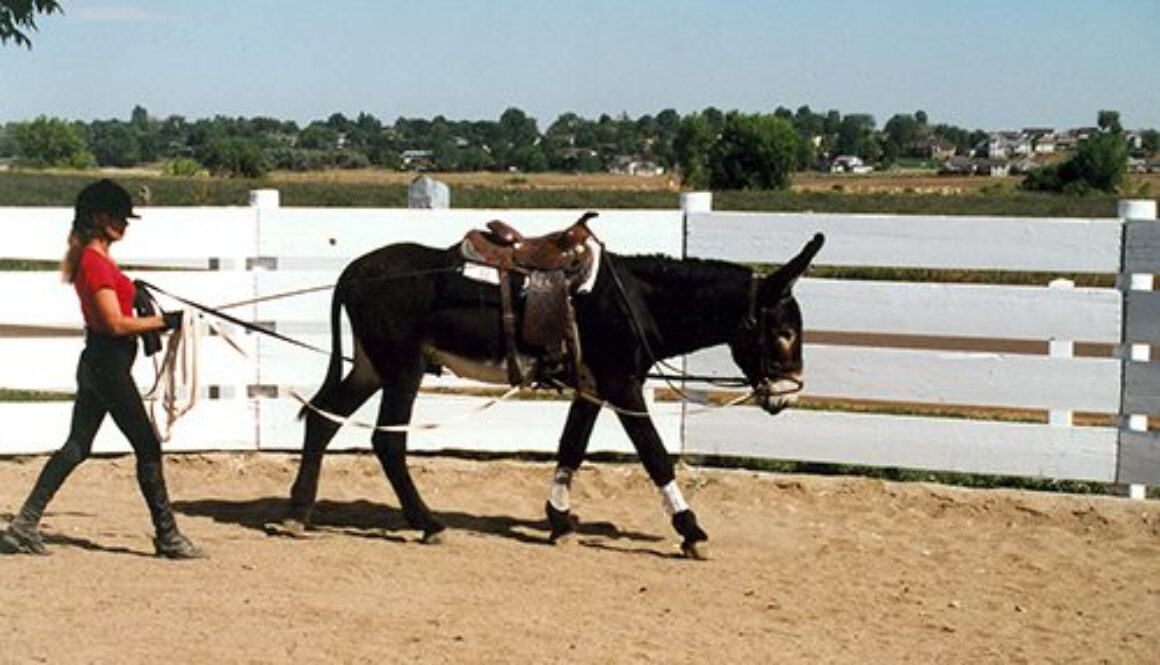MULE CROSSING: Donkey Training, Part 3
By Meredith Hodges
Prior to each training session with your donkey, review all that he has previously learned: Always lead him to and from the work station in a showmanship manner, holding the lead in your left hand with your right arm extended forward; groom him and clean his feet; review the turn on the forehand and turn on the hindquarters in the round pen; and send him forward to the rail in the round pen at the walk. You may have discovered that you need to follow him more closely than you would a horse or mule. Staying in the middle of the round pen while you lunge your donkey may not be practical to keep him moving. Just stay behind him and to the side while driving him forward with your lunge whip, touching him with it only when absolutely necessary. Match your steps with his steps—walk only as fast as HE chooses. If you get in a hurry, he will stop. Be sure to give the command to “whoa” each time you want him to stop, and then reward him.
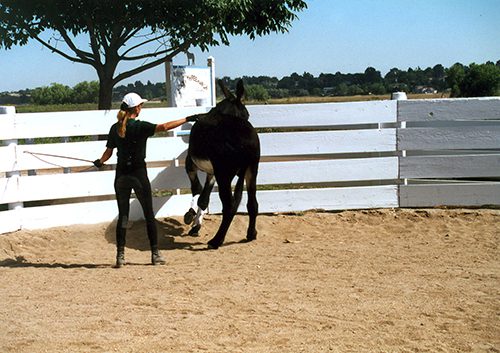 Now that he is moving out well at the walk, you can teach him a reverse. As he is walking forward easily around the round pen, turn away from him, completely around, until you are in front of him. Step toward him, lay the whip ahead of him and give the command to “reverse.” Be aware of his space. Do not rush at him, or he may turn improperly. You want him to turn into the rail and resume the opposite direction. Give him plenty of time to make the turn and ask him to “walk on.” If he has difficulty, take a few steps forward and, with the whip, tap him gently on the shoulder to encourage him to turn. There is a purpose to turning away from him to turn him rather than just running ahead of him. By turning back the opposite way that he is traveling, you are establishing a new direction of travel, as well as giving him time to see that there will be a change in his movement. Most donkeys learn this very quickly.
Now that he is moving out well at the walk, you can teach him a reverse. As he is walking forward easily around the round pen, turn away from him, completely around, until you are in front of him. Step toward him, lay the whip ahead of him and give the command to “reverse.” Be aware of his space. Do not rush at him, or he may turn improperly. You want him to turn into the rail and resume the opposite direction. Give him plenty of time to make the turn and ask him to “walk on.” If he has difficulty, take a few steps forward and, with the whip, tap him gently on the shoulder to encourage him to turn. There is a purpose to turning away from him to turn him rather than just running ahead of him. By turning back the opposite way that he is traveling, you are establishing a new direction of travel, as well as giving him time to see that there will be a change in his movement. Most donkeys learn this very quickly.
So far, your donkey has worked only in his halter. This is the point at which mules and donkeys may differ. Your donkey has learned the walk and the reverse. Now he needs to learn the command to “trot.” Some donkeys will take exception to this command if they do not see a purpose in it. It is at this point that you should introduce the saddle, and/or driving harness (if he is too small to ride). You should also introduce him to the bridle at the same time. Let him see the harness (or saddle), then slowly put it on him. Most donkeys will let you do this quite easily.
Once he is tacked up, send him, at the walk, to the rail of the round pen again. Then give the command to “trot” and move toward his hindquarters with the whip, shuffling your feet in the dirt to make some noise. If he trots at this point, do not strike him with the whip or he will stop. If he isn’t trotting, you may strike him with the whip once at the gaskin, above the hock. Then keep shuffling your feet and move forward as he does, maintaining the same distance between the two of you. Move your arms up and down in big motions to encourage him forward. If needed, you can strike the fence behind him. If you invade his space, he will stop. If he trots, even a few steps, stop him with the command to “whoa” and reward him for his compliance. Do this one more time to clarify that you DO want him to trot. Then end the lesson here. He will be better at the next session, and at each new session, he will offer more steps of trot. Each time he trots, ask him to go only as far as he is comfortable, as long as it is just a little farther than the time before, and ask him to trot only twice in each direction. Donkeys don’t appreciate too much repetition.
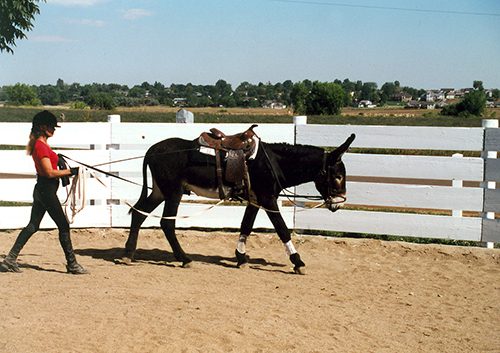 After his first lesson of trot, you can begin to integrate rein cues. During the second trot lesson, you will review all that he has learned up to the trot. Before you go to his trot lesson, you can attach your drivelines and ground-drive him through the walk and reverse while on the lines. He should have no trouble with you at his rear, since you have been lunging him from a close proximity from the beginning. Use your whip as you did for the turn on the haunches—at the shoulder for his turns, and at the gaskin to encourage him forward—but just touch him with it to remind him, don’t strike him. You want his movements to be smooth and correct, not abrupt. Pull as lightly as you can with a squeeze/release on the lines to encourage the turns, and make him move off more from your body language and the whip than you do with the lines. If he does well, stop, remove the lines, and send him back to the rail for his trot work—twice in each direction. (This means twice with trotting steps, not twice around the pen.) Then stop, reward him and tell him school’s out until the next time. Whether you come back tomorrow or a week later, rest assured that your donkey will be right where you left him in his training. They have an incredible memory!
After his first lesson of trot, you can begin to integrate rein cues. During the second trot lesson, you will review all that he has learned up to the trot. Before you go to his trot lesson, you can attach your drivelines and ground-drive him through the walk and reverse while on the lines. He should have no trouble with you at his rear, since you have been lunging him from a close proximity from the beginning. Use your whip as you did for the turn on the haunches—at the shoulder for his turns, and at the gaskin to encourage him forward—but just touch him with it to remind him, don’t strike him. You want his movements to be smooth and correct, not abrupt. Pull as lightly as you can with a squeeze/release on the lines to encourage the turns, and make him move off more from your body language and the whip than you do with the lines. If he does well, stop, remove the lines, and send him back to the rail for his trot work—twice in each direction. (This means twice with trotting steps, not twice around the pen.) Then stop, reward him and tell him school’s out until the next time. Whether you come back tomorrow or a week later, rest assured that your donkey will be right where you left him in his training. They have an incredible memory!
At the next lesson with your donkey, review all you did before and add turning through the middle of the pen, and turning both into the rail and away from the rail on the drivelines using your body language and your whip cues (as lightly as possible). Be clear with your verbal commands. For instance, tell him to “walk on,” and repeat the words as he walks on. When you wish to turn, give the command to “whoa,” then “gee” for a right turn, and “walk on” to continue forward. When you wish to turn left, ask him to “whoa” then use the command “haw” for the left turn, and “walk on” to continue forward. Be very careful not to pull too hard on the reins, as this will cause an over-reaction. After his ground-driving lesson, take off the drive lines and resume his lesson on lunging at the trot. Remember not to overdo any one stage of training. Two times seems to be the magic number, then go on to the next step. In other words, lunge at the walk twice each way, ground drive straight twice each way, ground drive reverse twice each way, ground drive turns twice each way, and lunge at the trot twice each way. This will keep him from becoming bored and resistant.
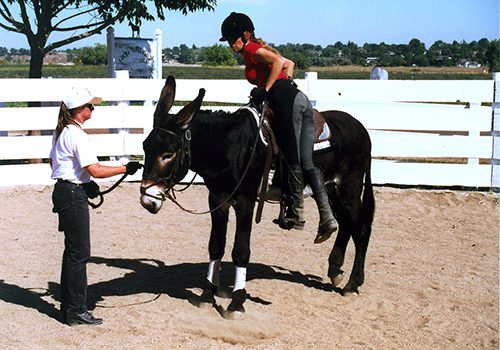 When he ground drives fairly well at the walk, you can mount him if he is a large enough donkey to ride. Mount him from both sides and dismount a few times at first. When he seems calm, you can stay aboard. Take a treat in your hand and encourage him to bend his head and neck around to each side to take the treat from your hand. At the same time, give short, light tugs on the rein on that side. This will encourage lightness in the bridle later on. Now he is ready to move with you aboard. It is best to use an assistant at this stage.
When he ground drives fairly well at the walk, you can mount him if he is a large enough donkey to ride. Mount him from both sides and dismount a few times at first. When he seems calm, you can stay aboard. Take a treat in your hand and encourage him to bend his head and neck around to each side to take the treat from your hand. At the same time, give short, light tugs on the rein on that side. This will encourage lightness in the bridle later on. Now he is ready to move with you aboard. It is best to use an assistant at this stage.
Have your assistant lead your donkey forwards a few steps with you aboard. Both of you should give the command to “walk on” as you squeeze with your legs once or twice, then the assistant can lead your donkey off. Have a riding crop in your hand to use if he does not comply. This will take the place of the lunge whip. Use it only if you have to and tap him only once lightly for every command you give. After just a few steps, say “whoa” and reward him, even if it is just two 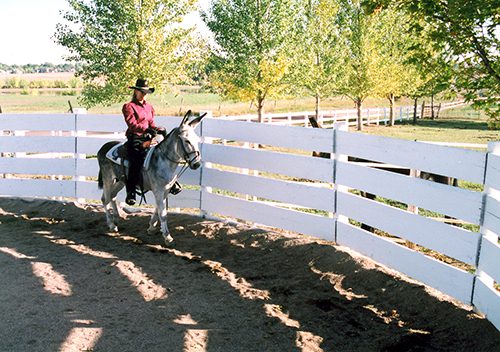 steps. You can continue this lesson until he has completed one rotation of the round pen in each direction. Then stop him with “whoa” and ask him to go back a step or two. Give light pulls on both reins in a squeeze/release fashion to start, then, as he begins to move his feet backwards, alternate your pressure on the reins with the front foot that is forward. If he does not wish to back, your assistant can help with pressure to his chest as you did on the lead. Always end your riding or ground-driving lesson with a back, and don’t pull so hard on the reins that he resists by jutting his head out. Encourage him to stay light in the bridle. Then finish your lesson with lunging at the trot.
steps. You can continue this lesson until he has completed one rotation of the round pen in each direction. Then stop him with “whoa” and ask him to go back a step or two. Give light pulls on both reins in a squeeze/release fashion to start, then, as he begins to move his feet backwards, alternate your pressure on the reins with the front foot that is forward. If he does not wish to back, your assistant can help with pressure to his chest as you did on the lead. Always end your riding or ground-driving lesson with a back, and don’t pull so hard on the reins that he resists by jutting his head out. Encourage him to stay light in the bridle. Then finish your lesson with lunging at the trot.
Donkeys learn a little differently than do mules or horses. Their responses are initially much slower but if you are clear with your intent, they learn completely. In halter training, your donkey learned to walk when you pull and to move away when you apply pressure to a certain area of his body. In the round pen, he learned to walk away from you and to walk and turn on the drivelines. He learned to walk with you on his back (with someone leading him to help reinforce the cues you were giving him). You and your assistant must be in tune with each other so as not to confuse your donkey. He will learn that the verbal command comes first, the legs come second (when you ride), and the crop (or whip) comes last. As he learns, he will begin to respond more closely to the initial verbal command. Ground driving is the same, with the reins in place of the legs. At first, you may need to use the voice, reins and whip, but as he learns, you will find him reacting sooner and sooner, until he is actually complying on the verbal command alone. Yes, donkeys are that smart!
You may have been having trouble with the trot on the lead up to this point, but now your donkey should be ready to do that as well. After your trotting lesson in the round pen, leave the area in a showmanship fashion, with the lead in your left hand and a treat in your extended right hand. Give the command to “trot” and slowly move into a trot yourself. If he still does not wish to trot, have your assistant move up from behind, just as you did when you were lunging him at the trot in the round pen, and he should comply. Take a few steps of trot, then ask him to “whoa,” give him his treat and “walk on.” It won’t take but a few lessons before he begins to understand the verbal commands. You just need to take it slowly enough and be consistent enough so that he has the opportunity to understand. Don’t get in a hurry, or you will find yourself in a sea of confusion!
To learn more about Meredith Hodges and her comprehensive all-breed equine training program, visit LuckyThreeRanch.com, MEREDITH HODGES PUBLIC FIGURE Facebook page, or call 1-800-816-7566. Check out her children’s website at JasperTheMule.com. Also, find Meredith on Pinterest, Instagram, MeWe, YouTube and Twitter.
Covered in TRAINING MULES & DONKEY: A LOGICAL APPROACH TO TRAINING, TRAINING WITHOUT RESISTANCE and EQUUS REVISITED at www.luckythreeranchstore.com.
© 1999, 2016, 2024 Lucky Three Ranch, Inc. All rights reserved.

